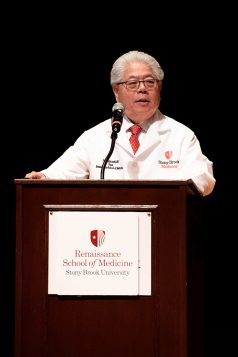136 students launch journey into Medicine at traditional White Coat Ceremony
At the Renaissance School of Medicine’s (RSOM) White Coat Ceremony, 136 incoming students donned their physician “white coats” and took the Hippocratic Oath for the first time. Held at Stony Brook University’s Staller Center, the annual ceremony brings students, their families, and faculty together as the academic year begins and members of the Class of 2027 embark on their journeys toward becoming physicians. The RSOM has held the White Coat Ceremony since 1998.
The incoming students are a select group, and according to RSOM administrators is one of the most diverse classes in the school’s history. Only 8.5 percent of all applicants to the RSOM for 2023-24 were accepted into the program. Approximately 20 percent of class consists individuals from historically marginalized communities, and 54 percent of the class are women.
Collectively the students received their undergraduate degrees from 66 different colleges and universities from around the country. Stony Brook University (20) and Cornell University (17) were the undergraduate schools with the most representation. The class has a combined median undergraduate GPA of 3.89. While many of the new students are from different areas of the country, 77 percent hail from New York State.
“To the Class of 2027, you are entering medicine at an exhilarating time,” said Peter Igarashi, MD, Dean of the RSOM, who presided over his first White Coat Ceremony. “Scientific discoveries in medicine are occurring at a breathtaking and awe-inspiring rate. Diseases that were rapidly fatal when I was a medical student, such as multiple myeloma and leukemia, are now routinely treated. Advances in human genetics have enabled truly personalized medicine, and the development of an effective Covid-19 vaccine less than one year after the onset of the pandemic saved almost 20 million lives and underscored the essential role that science plays in public health.”
All of the students have a story as to how and why they have chosen Medicine as a profession.
For New York City native Adam Bruzzese, an NYU graduate, his family’s difficulties and challenges they had within the healthcare system was a big trigger to increasing his passion for medicine. Adam’s 11-year-old sister had mysteriously become paralyzed, and he played an integral part in providing her healthcare as a teenager and college student. He witnessed disparities of care as she moved through the health system, plus the myriad of tests and physician opinions along the way. It was eventually determined her paralysis was caused by Lyme Disease.
Manteca, California native Jasmine Stansil, a standout student in high school and at the University of California, San Diego, was always fascinated by the human body as a kid. She also became captivated by how physicians can have an incredible impact on human life when she watched Untold Stories of the ER. But she was most inspired to pursue Medicine because of her grandmother, who endured multiple strokes.
“Watching doctors provide her care made me want to do the same for others,” says Stansil. “I am hoping to become an academic physician who will provide clinical care, teach and conduct research.”
Jerome Belford, one of the 20 class members who attended Stony Brook University as an undergraduate, described his interest in medicine as coming from a “passion that stems from a desire to promote physical and emotional health and wellness.”
From Long Island, Belford is a volunteer EMT who decided to attend the RSOM because of its broad research and clinical opportunities and standout education that provides experiential and hands-on medical training. He hopes to eventually provide patients who have historically not had access to the best medical resources improved care, either as an emergency physician or though primary care as an internist.
White coat ceremonies are an initiation rite and are symbolic to Medicine as a profession that combines professionalism with scientific excellence and compassionate care. In an era of telemedicine, aging populations, new knowledge about infections and diseases, and emerging technologies, Medicine remains a dynamic and changing profession that continues to impact the health and well-being of society.
All photos by Arthur Fredericks














